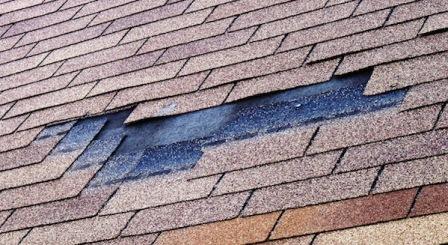Mastering Roof Inspections: Underlayment, Part 2
by Kenton Shepard and Nick Gromicko, CMI®
- asphalt-saturated felt;
- rubberized asphalt; and
- non-bitumen synthetic.
We’ll start by talking about felt.
ASPHALT-SATURATED FELT

One of the most common types of underlayment used in residential, steep-slope applications is a black, asphalt-saturated felt paper. Felt underlayment may be made from either an organic or fiberglass substrate, although the organic is much more common. It’s called “organic” underlayment because it has a cellulose base.
Felt underlayment is water-resistant, not waterproof. It’s available in two thicknesses: 15-pound and 30-pound. Fifteen-pound felt has a perm-rating of about 5, although this number can rise in high-humidity conditions.
Thirty-pound felt is more resistant to damage during installation of the roof-covering material and will protect the roof longer if it should somehow become exposed to weather. The difference is obvious, once you see them together. Thirty-pound is much thicker and stiffer. It’s what you see being installed here.
INSTALLATION of FELT UNDERLAYMENT
Slope Limitations

In low-slope conditions -- that is, from 2:12 up to 4:12 -- felt courses should overlap a minimum of 19 inches. This will provide a double layer of underlayment across the entire roof. The photo above shows what a low-slope installation looks like.

In steep-slope conditions -- that is, 4:12 and steeper -- upper courses of felt underlayment should overlap lower courses by at least 2 inches. Here, you can see the difference between the underlayment overlapped 2 inches on the upper roof, and overlapped 19 inches on the lower, less steep roof.
Fastening


Felt is usually fastened with staples, but in high-wind areas, plastic windstrips may be used along the edges to prevent tearing.

Felt may also be attached in high-wind areas using plastic cap nails, such as those pictured above. Plastic caps offer better wind resistance than staples and also help prevent leakage through the hole made by the fastener.
Edge Metal Laps

Felt underlayment should overlap the edge metal at the eaves and be overlapped by edge metal on the rakes. This is also true for rubberized asphalt underlayment, but not necessarily true for synthetics.
FELT UNDERLAYMENT FAILURE
Asphalt-saturated felt may fail for a number of reasons.
Poor Quality
Poor quality is one reason for felt underlayment failure. A number of ASTM standards exist which offer specifications for asphalt-saturated felt.
Many manufacturers produce asphalt-saturated paper labeled “Underlayment,” “15-lb.” or “30-lb.,” which do not comply with any standards, and which are often saturated to a lower level than an ASTM-compliant underlayment. These underlayments typically absorb water more readily and fail sooner. Water absorption can cause wrinkling as the product expands. These wrinkles may telegraph through to roof-covering products, such as thinner asphalt shingles.
Water from the felt may be absorbed by the roof deck, which can cause problems with expansion and contraction of the deck.
You won’t be able to tell by looking whether a product complies with any standards, but if you see what looks like premature failure or distortion of the underlayment, it may be caused by sub-standard underlayment.
Loss of Volatiles
Over time, volatile compounds in the asphalt will dissipate, and the underlayment will become more fragile and moisture-absorbent. This will happen more quickly when felt is exposed to heat. The source of heat may be a warm climate, a particular type of roof-covering material, poor roof-structure ventilation, or a combination of all these.


**************************************************
Learn how to master a roof inspection from beginning to end by reading the entire InterNACHI series: Mastering Roof Inspections.
Take InterNACHI’s free, online Roofing Inspection Course
Mastering Roof Inspections
Roofing Underlayment Types
Inspecting Underlayment on Roofs
Fall-Arrest Systems
Roofing (consumer-targeted)
More inspection articles like this

